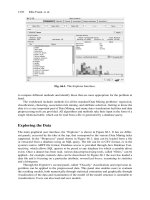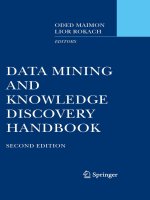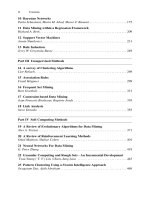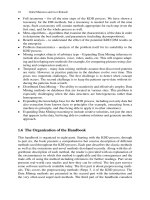Web Mining and Knowledge Discovery of Usage Patterns
Bạn đang xem bản rút gọn của tài liệu. Xem và tải ngay bản đầy đủ của tài liệu tại đây (413.55 KB, 25 trang )
1
Web Mining and Knowledge Discovery of Usage Patterns
CS 748T Project (Part I)
Yan Wang
February, 2000
2
Abstract
Web mining is a very hot research topic which combines two of the activated research areas:
Data Mining and World Wide Web. The Web mining research relates to several research
communities such as Database, Information Retrieval and Artificial Intelligence. Although
there exists quite some confusion about the Web mining, the most recognized approach is to
categorize Web mining into three areas: Web content mining, Web structure mining, and Web
usage mining. Web content mining focuses on the discovery/retrieval of the useful
information from the Web contents/data/documents, while the Web structure mining
emphasizes to the discovery of how to model the underlying link structures of the Web. The
distinction between these two categories isn't a very clear sometimes. Web usage mining is
relative independent, but not isolated, category, which mainly describes the techniques that
discover the user's usage pattern and try to predict the user's behaviors.
This paper is a survey based on the recently published research papers. Besides providing an
overall view of Web mining, this paper will focus on Web usage mining. Generally speaking,
Web usage mining consists of three phases: Pre-processing, Pattern discovery and Pattern
analysis. A detailed description will be given for each part of them, however, special
attention will be paid to the user navigation patterns discovery and analysis. The user privacy
is another important issue in this paper. An example of a prototypical Web usage mining
system, WebSIFT, will be introduced to make it easier to understand the methodology of how
to apply data mining techniques to large Web data repositories in order to extract usage
patterns. Finally, along with some other interested research issues, a brief overview of the
current research work in the area of Web usage mining is included.
1. Introduction
It is not exaggerated to say the Web World Web is the most excited impacts to the human
society in the last 10 years. It changes the ways of doing business, providing and receiving
education, managing the organization etc. The most direct effect is the completed change of
3
information collection, conveying, and exchange. Today, Web has turned to be the largest
information source available in this planet. The Web is a huge, explosive, diverse, dynamic
and mostly unstructured data repository, which supplies incredible amount of information,
and also raises the complexity of how to deal with the information from the different
perspectives of view – users, Web service providers, business analysts. The users want to
have the effective search tools to find relevant information easily and precisely. The Web
service providers want to find the way to predict the users’ behaviors and personalize
information to reduce the traffic load and design the Web site suited for the different group of
users. The business analysts want to have tools to learn the users/consumers’ needs. All of
them are expecting tools or techniques to help them satisfy their demands and/or solve the
problems encountered on the Web. Therefore, Web mining becomes an active and popular
research field.
Web mining is the term of applying data mining techniques to automatically discover and
extract useful information from the World Wide Web documents and services [7]. Although
Web mining puts down the roots deeply in data mining, it is not equivalent to data mining.
The unstructured feature of Web data triggers more complexity of Web mining. Web mining
research is actually a converging area from several research communities, such as Database,
Information Retrieval, Artificial Intelligence [8], and also psychology and statistics as well.
As a forerunner of my term project specified in Web mining, the paper is organized as
following:
Section 1 – Introduction
Section 2 – A general introduction of the Web data mining
Section 3 – Usage mining on the Web
Section 4 – A usage mining system: WebSIFT
Section 5 – Personalization vs. User navigation pattern
Section 6 – Privacy on the Web
Section 7 – Related Work
Section 8 – Conclusion
4
2. Web Data Mining
2.1 Overview
As many believe, it is Oren Etzioni first proposed the term of Web mining in his paper [7]
1996. In this paper, he claimed the Web mining is the use of data mining techniques to
automatically discover and extract information from World Wide Web documents and
services. Many of the following researchers cited this explanation in their works. In the same
paper, Etzioni came up with the question: Whether effective Web mining is feasible in
practice? Today, with the tremendous growth of the data sources available on the Web and
the dramatic popularity of e-commerce in the business community, Web mining has become
the focus of quite a few research projects and papers. Some of the commercial consideration
has presented on the schedule.
In both [7] and [8], they suggested a similar way to decompose Web mining into the
following subtasks:
a. Resource Discovery: the task of retrieving the intended information from Web.
b. Information Extraction: automatically selecting and pre-processing specific information
from the retrieved Web resources.
c. Generalization: automatically discovers general patters at the both individual Web sites
and across multiple sites.
d. Analysis: analyzing the mined pattern.
In brief, Web mining is a technique to discover and analyze the useful information from the
Web data. The authors of [10] claims the Web involves three types of data: data on the Web
(content), Web log data (usage) and Web structure data. The authors of [5] classified the data
type as content data, structure data, usage data, and user profile data. M. Spiliopoulou [14]
categorized the Web mining into Web usage mining, Web text mining and user modeling
mining; while today the most recognized categories of the Web data mining are Web content
5
mining, Web structure mining, and Web usage mining [2,8,10]. It is clear that the
classification is based on what type of Web data to mine.
2.2 Web Content Mining
Web content mining describes the automatic search of information resource available online
[10], and involves mining web data contents. In the Web mining domain, Web content mining
essentially is an analog of data mining techniques for relational databases, since it is possible
to find similar types of knowledge from the unstructured data residing in Web documents.
The Web document usually contains several types of data, such as text, image, audio, video,
metadata and hyperlinks. Some of them are semi-structured such as HTML documents, or a
more structured data like the data in the tables or database generated HTML pages, but most
of the data is unstructured text data. The unstructured characteristic of Web data force the
Web content mining towards a more complicated appoach.
The Web content mining is differentiated from two different points of view [3]: Information
Retrieval View and Database View. R. Kosala et al. [8] summarized the research works done
for unstructured data and semi-structured data from information retrieval view. It shows that
most of the researches use bag of words, which is based on the statistics about single words in
isolation, to represent unstructured text and take single word found in the training corpus as
features. For the semi-structured data, all the works utilize the HTML structures inside the
documents and some utilized the hyperlink structure between the documents for document
representation. As for the database view, in order to have the better information management
and querying on the Web, the mining always tries to infer the structure of the Web site of to
transform a Web site to become a database.
S. Chakrabarti [19] provides a in-depth survey of the research on the application of the
techniques from machine learning, statistical pattern recognition, and data mining to
analyzing hypertext. It’s a good resource to be aware of the recent advances in content
mining research.
6
Multimedia data mining is part of the content mining, which is engaged to mine the high-level
information and knowledge from large online multimedia sources. Multimedia data mining
on the Web has gained many researchers’ attention recently. Working towards a unifying
framework for representation, problem solving, and learning from multimedia is really a
challenge, this research area is still in its infancy indeed, many works are waiting to be done.
For the details about multimedia mining, please refer [8, 18] to find the related resource
information.
2.3 Web Structure Mining
Most of the Web information retrieval tools only use the textual information, while ignore the
link information that could be very valuable. The goal of Web structure mining is to generate
structural summary about the Web site and Web page. Technically, Web content mining
mainly focuses on the structure of inner-document, while Web structure mining tries to
discover the link structure of the hyperlinks at the inter-document level. Based on the
topology of the hyperlinks, Web structure mining will categorize the Web pages and generate
the information, such as the similarity and relationship between different Web sites.
Web structure mining can also have another direction – discovering the structure of Web
document itself. This type of structure mining can be used to reveal the structure (schema) of
Web pages, this would be good for navigation purpose and make it possible to
compare/integrate Web page shemes. This type of structure mining will facilitate introducing
database techniques for accessing information in Web pages by providing a reference schema.
The detailed works on it can be referred to [17].
What is on earth the structural information, and how to discover it? S. Madria et al. [17] gave
a detailed description about how to discover interesting and informative facts describing the
connectivity in the Web subset, based on the given collection of interconnected web
documents. The structural information generated from the Web structure mining includes the
7
follows: the information measuring the frequency of the local links in the Web tuples in a
Web table; the information measuring the frequency of Web tuples in a Web table containing
links that are interior and the links that are within the same document; the information
measuring the frequency of Web tuples in a Web table that contains links that are global and
the links that span different Web sites; the information measuring the frequency of identical
Web tuples that appear in a Web table or among the Web tables.
In general, if a Web page is linked to another Web page directly, or the Web pages are
neighbors, we would like to discover the relationships among those Web pages. The relations
maybe fall in one of the types, such as they related by synonyms or ontology, they may have
similar contents, both of them may sit in the same Web server therefore created by the same
person. Another task of Web structure mining is to discover the nature of the hierarchy or
network of hyperlinks in the Web sites of a particular domain. This may help to generalize the
flow of information in Web sites that may represent some particular domain, therefore the
query processing will be easier and more efficient.
Web structure mining has a nature relation with the Web content mining, since it is very likely
that the Web documents contain links, and they both use the real or primary data on the Web.
It’s quite often to combine these two mining tasks in an application.
2.4 Web Usage Mining
Web usage mining tries to discovery the useful information from the secondary data derived
from the interactions of the users while surfing on the Web. It focuses on the techniques that
could predict user behavior while the user interacts with Web. M. Spiliopoulou [14] abstract
the potential strategic aims in each domain into mining goal as: prediction of the user’s
behavior within the site, comparison between expected and actual Web site usage, adjustment
of the Web site to the interests of its users. There are no definite distinctions between the
Web usage mining and other two categories. In the process of data preparation of Web usage
mining, the Web content and Web site topology will be used as the information sources,
8
which interacts Web usage mining with the Web content mining and Web structure mining.
Moreover, the clustering in the process of pattern discovery is a bridge to Web content and
structure mining from usage mining.
There are lots of works have been done in the IR, Database, Intelligent Agents and Topology,
which provide a sound foundation for the Web content mining, Web structure mining. Web
usage mining is a relative new research area, and gains more and more attentions in recent
years. I will have a detailed introduction in the next section about usage mining, based on
some up-to-date research works.
3. The Usage Mining on the Web
Web usage mining is the application of data mining techniques to discover usage patterns
from Web data, in order to understand and better serve the needs of Web-based applications
[5]. In the same paper, the Web usage mining is parsed into three distinctive phases:
preprocessing, pattern discovery, and pattern analysis. I think it is an excellent approach to
define the usage mining procedure. It also clarified the research sub direction of the Web
usage mining, which facilitates the researchers to focus on each individual process with
different applications and techniques. With the assistance of the diagram of the high-level
Web usage mining process shown in Figure 1, which is presented in [4, 5, 6], reader may
understand the architecture of the Web Usage Mining easily. I will give a detailed
introduction as follows, encompassing these three-phase processing.
3.1 Data Pre-processing for Mining
From the technique point of view, Web usage mining is the application of data mining
techniques to usage logs (secondary Web data) of large Web data repositories. The purpose of
it is to produce results that can be used in the design tasks such as Web site design, Web
server design and of navigating through a Web site [4]. However, before applying the data
mining algorithm, we must perform a data preparation to convert the raw data into the data
9
abstraction necessary for the further process. The data can be collected at the server-side,
client-side, proxy servers, or obtained from database. For each type of data collection, the
difference is not only the location, but also the available data type, the segment of population
from which the data was collected and the method of implementation [5]. The information
sources available to mine include Web usage logs, Web page descriptions, Web site topology,
user registries, and questionnaire [14]. It’s natural to think that the preprocess has three
different conversions: Usage converting, Content converting, and Structure converting.
Since the data abstraction is very important in the data preprocess, it’s necessary to clarify the
definitions of the related data abstractions before the description of the different type of the
data converting. The following definitions are from the Web characterization terminology &
definition sheets drafty published by the World Wide Web Committee Web usage
characterization activity ( />terms/).
User –The principal using a client to interactively retrieve and render resources or resource
manifestations.
Page view – Visual rendering of a Web page in a specific client environment at a specific
point in time.
10
Click stream – A sequential series of page view request.
User session – A delimited set of user clicks (click stream) across one or more Web servers.
Server session (visit) – A collection of user clicks to a single Web server during a user
session. Also called a visit.
Episode - A subset of related user clicks that occur within a user session.
3.1.1 Content Preprocessing
Content preprocessing is the process of converting text, image, scripts and other files into the
forms that can be used by the usage mining. It’s not hard to understand that the Web content
can be used to filter the input to, or output from the pattern discovery algorithm [5]. R.
Cooley also described how the page views play the important roles in the preprocessing. For
the content of static page views, the preprocessing can be easily done by parsing the HTML
and reformatting the information or running additional algorithm as desired. It would be
much more complicated to the content of dynamic page views. To perform the preprocessing,
the content of each page view must be “assembled”, either by an HTTP request from a
crawler, or a combination of template, script, and the database accesses. Please refer to the
[5] for the detailed information.
3.1.2 Structure Preprocessing
The structure of a Web site is formed by the hyperlinks between page views. The structure
preprocessing can be treated similar as the content preprocessing. However, each server
session may have to construct a different site structure than others.
3.1.3 Usage Preprocessing
The inputs of the preprocessing phase may include the Web server logs, referral logs,
registration files, index server logs, and optionally usage statistics from a previous analysis.









